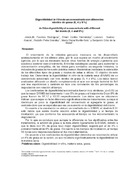Mostrar el registro sencillo del ítem
Digestibilidad In Vitro de un concentrado con diferentes niveles de grasa (0, 4 y 8 %)
| dc.contributor.author | Fuentes Rodríguez, Jesús Manuel | |
| dc.contributor.other | Cortés Hernández, Efraín | |
| dc.contributor.other | Suárez García, Lorenzo | |
| dc.contributor.other | Peña Oranday, José Rodolfo | |
| dc.contributor.other | Murillo Soto, María Elena | |
| dc.contributor.other | Ortíz de la Rosa, Benjamín | |
| dc.date.accessioned | 2019-08-23T14:36:56Z | |
| dc.date.available | 2019-08-23T14:36:56Z | |
| dc.date.issued | 01-02-2003 | |
| dc.identifier.uri | http://repositorio.uaaan.mx:8080/xmlui/handle/123456789/46008 | |
| dc.description | En la actualidad la competencia de alimentos entre humanos y animales domésticos, es uno de los mayores problemas para las naciones en vías de desarrollo, en donde existe un importante déficit de alimentos. Por otro lado la industria pecuaria mexicana se ha desarrollado a un ritmo acelerado en los últimos años, ocasionando con esto una gran demanda de alimentos balanceados para cumplir con las necesidades de la población animal. | es_MX |
| dc.description.abstract | "El crecimiento de la industria pecuaria mexicana se ha desarrollado aceleradamente en los últimos años, por lo que supera en mucho al crecimiento agrícola, por lo que es necesario buscar otras fuentes de energía y proteína que ayuden a sostener este crecimiento. Entre las estrategias usadas para aumentar la concentración energética, de las dietas para rumiantes en engorda intensiva, la inclusión de grasas se ha vuelto práctica común; haciéndose necesaria la valoración de los diferentes tipos de grasas y niveles de estas a utilizar. El objetivo de este trabajo fue: Determinar la digestibilidad in vitro de la materia seca (DIVMS) de un concentrado adicionado con tres niveles de grasa (0, 4 y 8%). Los datos fueron analizados utilizando un diseño completamente al azar con arreglo factorial de 3x6 con tres repeticiones y también se hizo una correlación de los porcentajes de degradación con relación al tiempo." | es_MX |
| dc.format | es_MX | |
| dc.language | Español | es_MX |
| dc.publisher | Universidad Autónoma Agraria Antonio Narro | es_MX |
| dc.rights | Acceso Abierto | es_MX |
| dc.rights.uri | CC BY-NC-ND - Atribución-NoComercial-SinDerivadas | es_MX |
| dc.subject | CIENCIAS AGROPECUARIAS Y BIOTECNOLOGÍA | es_MX |
| dc.subject.other | Digestibilidad in-vitro | es_MX |
| dc.subject.other | Materia seca | es_MX |
| dc.subject.other | Grasa | es_MX |
| dc.title | Digestibilidad In Vitro de un concentrado con diferentes niveles de grasa (0, 4 y 8 %) | es_MX |
| dc.type | Artículo | es_MX |
| dc.description.abstractEn | "The growth of the livestock industry has developed rapidly in recent years, it even has surpassed the growth of the agricultural sector in Mexico, therefore, it is necessary to find alternative sources of energy and protein that help to maintain this growth. Among the strategies used to increase the energy concentration of the diets for ruminants in intensive conditions, the inclusion of fat has become a common practice; making it necessary the appraisal of the different types and levels of fat to use. The objective of this work was: to determine the in-vitro digestibility of dry matter (DIVMS) of a concentrate with three levels of fat (0, 4 and 8%). The data was analyzed using a completely random design with factorial array of 3x6 with three repetitions and also a correlation of the percentages of degradation with time. The DIVMS found were similar, (p>0.05) since the DIVMS of treatment 1 with 0% of grease and treatment 3 with 8% of fat were of 97.17 and 93.33 respectively. The data that was obtained indicates that although there was no significant difference among treatments, there was a small decrease in the DIVMS. As for the correlation the result obtained r = 0.9221, at o.o1 level, indicates that it exists a high correlation between digestibility and the time of incubation, since the DIVMS increased with time.. Therefore, it was concluded that although the difference was not significant among treatments, the addition of fat to the diet, slightly decreased the DIVMS, due to the fact that the diet with 0% fat had slightly better digestibility, followed by that of 4% and subsequently that of 8% fat. As for the time of incubation, the 48 hour one had better results in the three treatments. According to the coefficients of digestibility obtained, it is recommended to use a level of 4% fat in the ratio, since it does not affect significantly the DIVMS." | |
| dc.type.version | Versión publicada | es_MX |
| dc.audience | Estudiantes | es_MX |
| dc.audience | Investigadores | es_MX |
| dc.publisher.place | Saltillo, Coahuila, México | es_MX |
